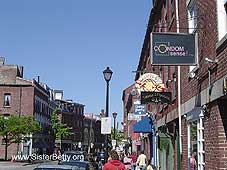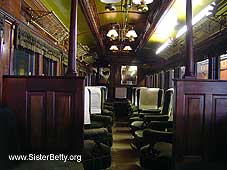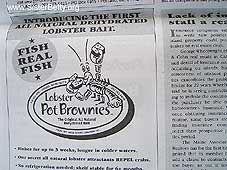 When
I was about ten years old, my father brought home a book called "Two
Feet Between the Rails". This heavy volume detailed the history
of tiny, narrow-gauge railroads in the far away state of Maine. I
spent hours pouring through the book and imagining life in the early 1900s
riding these small trains. Two decades and four thousand miles later,
I saw the
trains for myself. When
I was about ten years old, my father brought home a book called "Two
Feet Between the Rails". This heavy volume detailed the history
of tiny, narrow-gauge railroads in the far away state of Maine. I
spent hours pouring through the book and imagining life in the early 1900s
riding these small trains. Two decades and four thousand miles later,
I saw the
trains for myself.
The United States experienced a boom in railroad
building after the Civil War. While most of the country was linked
by standard gauge lines, remote or geographically isolated areas often
installed narrow gauge lines as they were cheaper and easier to build.
The smallest of these  were
the two-foot
gauge railroads of Maine. Between 1881 and the Great Depression, these
tiny railroads provided freight and passenger service throughout the state.
Highways, trucks and the recession doomed the lines and they were torn
up and scrapped. In 1991, the Maine Narrow Gauge Railroad Museum was created
to collect and restore the remaining pieces of these little trains.
(Gauge refers to the space between the rails. Standard gauge measures
four feet, eight and one half inches between the rails and is the gauge
used in most modern railroads. By comparison, narrow gauge lines
in Maine had just twenty four inches between the rail - less than one half
the size of standard gauge.) were
the two-foot
gauge railroads of Maine. Between 1881 and the Great Depression, these
tiny railroads provided freight and passenger service throughout the state.
Highways, trucks and the recession doomed the lines and they were torn
up and scrapped. In 1991, the Maine Narrow Gauge Railroad Museum was created
to collect and restore the remaining pieces of these little trains.
(Gauge refers to the space between the rails. Standard gauge measures
four feet, eight and one half inches between the rails and is the gauge
used in most modern railroads. By comparison, narrow gauge lines
in Maine had just twenty four inches between the rail - less than one half
the size of standard gauge.)
 The
museum tracks are just a few feet from my hotel. After breakfast
at the Port
Hole Cafe with lobstermen selling the day's catch to a broker across
the street, I head down to the museum. It would be easy to mistake
the trains here for an amusement park ride; the size of the cars and the
track are so small they resemble toys, not serious trains which once transported
a significant portion of Maine's economic output. The
museum tracks are just a few feet from my hotel. After breakfast
at the Port
Hole Cafe with lobstermen selling the day's catch to a broker across
the street, I head down to the museum. It would be easy to mistake
the trains here for an amusement park ride; the size of the cars and the
track are so small they resemble toys, not serious trains which once transported
a significant portion of Maine's economic output.
I really want to see the steam locomotives, so
I tell my sob story of reading the book when I was ten and driving across
country to the museum staff. They dispatch a tall, young, lanky volunteer
to take me out to the dark
and dirty engine house (this is how they described it to me).
The young volunteer repeatedly apologizes for the cramped and tight space.
The engine house is too small to allow much photography, but I'm amazed
to be standing next to century-old
locomotives I've only ever seen in photographs.
 After
the private tour of the engine house and a ride behind a more modern
diesel locomotive along the Portland waterfront, I wander through the
museum itself. The miniature passenger
cars are amazingly
detailed and well restored. I wonder what it would cost to have them
fire up one of the old steamers for a private run, but I decide it probably
would be outside my traveling budget. After
the private tour of the engine house and a ride behind a more modern
diesel locomotive along the Portland waterfront, I wander through the
museum itself. The miniature passenger
cars are amazingly
detailed and well restored. I wonder what it would cost to have them
fire up one of the old steamers for a private run, but I decide it probably
would be outside my traveling budget.
My visit to the museum complete, I head downtown
for a haircut. The woman who cuts my hair clearly is not comfortable
using clippers and she's a bit shaky in her work. I glance in the
mirror back at the hotel and decide I either need to find a barber to fix
the problem or shave my head entirely. I go back out in search of
a barber/repair person and find a tiny shop lodged in the basement of a
building. The ancient barber (who may well remember riding the trains
when they weren't in a museum) says to me: "A woman did this."
I nod. He says: "I  can
tell. Only a woman does something like this." can
tell. Only a woman does something like this."
People in Maine have an accent that sounds a bit
like sheep with peanut butter stuck to top of their mouths. It is
wonderful to listen to, especially when spoken by shipyard workers on their
way home from building oil platforms.
In cities like San Francisco, where most of the
men spend time working at computer terminals or sitting behind desks, we
like to pretend we still have a connection to manual labor. We buy
work boots and overalls to wear while we fix dripping faucets. The
flimsy nature of this facade is made obvious in a place like Portland where
men heave dripping traps full of lobsters onto docks, weld
ships together, build
boats and pour
concrete. The image of the hardworking laborer still holds a
lock on the idea of masculinity, but we'd rather it didn't come with so
much...manual labor. The older I get, the less I enjoy working in
the intellectual  realm
and think more and more that I'd like to own a nice little farm on the
edge of a town somewhere. The reality of this dream might violate
my fantasy, but it is nice to consider. realm
and think more and more that I'd like to own a nice little farm on the
edge of a town somewhere. The reality of this dream might violate
my fantasy, but it is nice to consider.
It is hard not to love a state where people have
so much flannel and facial hair.
Portland seems to be a rather liberal place.
They have a troupe
of nuns, pot
brownies, a big safer-sex condom
store right downtown and bookstores hawking just about every gay title
you can imagine.
Speaking of liberal gay places, tomorrow
I go to Provincetown...
[Click on any photo for a larger
image]
 
 
 
 
 |













